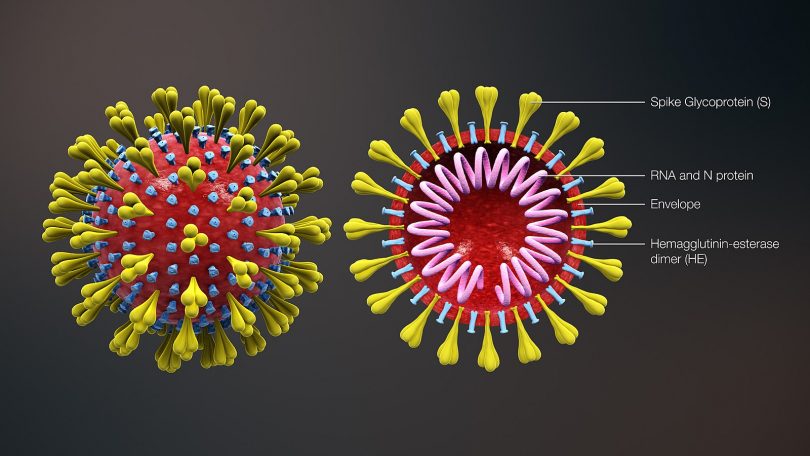
A medical animation of the coronavirus. Image: Wikimedia.
Emergency provisions are being put in place across the ACT and NSW in response to the coronavirus pandemic, including a declared public health emergency in Canberra. There are currently 134 confirmed COVID-19 cases in NSW, primarily in Sydney, while the ACT’s second case was confirmed on Sunday night.
The declaration will enable the Chief Health Officer to enforce quarantine, but this would be a last resort as the focus remains on containing the virus and flattening the curve of infection in order to manage the impact on health resources.
NSW Premier Gladys Berejiklian told ABC News that police will force people to stay at home if they don’t voluntarily self-isolate.
“We can’t pretend that these are normal circumstances, because they’re not,” she said.
In the ACT, schools will remain open with protocols to reduce risks, although measures are in place to localise the closure of a school should a confirmed case emerge. Measures in place from this morning include cancellation of assemblies and excursions, parent-teacher nights and other larger gatherings.
The NSW Department of Education has advised schools to adopt social distancing measures as well as cancelling assemblies, excursions, travel, some events and conferences.
It is possible that national institutions may also close, but those decisions remain pending as the situation develops.
ACT Chief Minister Andrew Barr stressed that decisions being taken now will be in place “until a vaccine is developed or so many in the community have the virus that natural immunity is in place”.
“There are no short term solutions to this,” he said. “There is only risk reduction. This is an exercise across the world about risk minimisation. That’s the best we can do.
“The message I want to convey is that this is not one or two weeks, it will be for the rest of the year. Decisions we undertake now will impact us for the rest of the year. I want to reassure everyone that decisions the National Cabinet is taking are based on consensus and the best possible advice to slow the spread of the virus.”
But when should you get tested, given that the symptoms of COVID-19 are so similar to many other common respiratory illnesses? Medical experts are warning that if everyone with the sniffles is swabbed, the demands could exhaust testing resources.
Australia’s Chief Medical Officer Brendan Murphy has written to GPs, saying, “Unfortunately, the extreme pressure on our personal protective equipment (PPE) stocks continues, and the situation regarding pathology test kits, reagents and swabs is deteriorating rapidly, with kits no longer being available in some regions of the country”.
“Pathology collection centres have also experienced large backlogs in testing appointments in some parts of Australia, and emergency testing facilities have had to be established in some areas to ensure that urgent patients can get access to testing,” he added.
In the ACT, the Weston Walk-in Centre is reporting waits of up to four hours and warns that people who don’t meet current testing criteria can be turned away.
With a caveat that guidelines may change rapidly, the current criteria for being tested are as follows:
- Patients who have been travelling internationally in the 14 days before they started showing symptoms OR have been in close contact with a confirmed COVID-19 case in the 14 days before showing symptoms; AND have a fever OR an acute respiratory infection (eg shortness of breath, cough, sore throat) with or without fever.
- Healthcare workers who have direct contact with patients AND acute respiratory symptoms (eg shortness of breath, sore throat, cough) AND a fever greater than or equal to 37.5 degrees, whether or not they have had recent international travel.
- Patients who are critically ill with pneumonia (requiring hospital admission) where no cause has been identified, whether or not they have recent international travel.
The most common symptoms of COVID-19 are fever (88%), cough (68%), fatigue (38%), shortness of breath (18%), muscle or joint pain (15%), sore throat (14%), headache (14%), nausea or vomiting (5%), nasal congestion (5%) and diarrhea (4%). People will most commonly get symptoms around five to seven days after exposure.
Most medical practices say that people who suspect they have the virus should call ahead and seek advice rather than arriving unannounced at their GP’s office. Alternative arrangements include conducting a consultation via phone or internet web meeting and providing a test request to a participating pathology laboratory for a swab.
People who are concerned and want further information on the virus, can call the Australian Government’s Coronavirus Health Information Line on 1800 020 080. The line operates 24 hours a day, seven days a week. Information is also available through the Department of Health.








